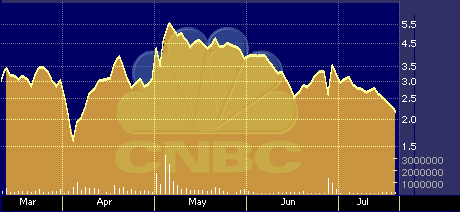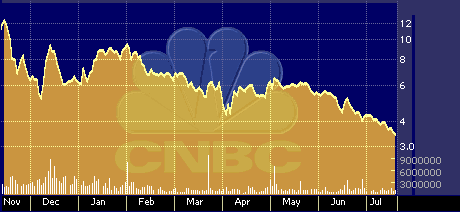
Microsoft Woes May Boost Linux Firms
Microsoft Woes May Boost Linux Firms
By Hal Plotkin
Silicon Valley Correspondent
Analysts say Microsoft Corp.’s {MSFT} prolonged legal woes create uncertainty in the marketplace that will further boost sales at rival companies that provide documentation and service for the competing Linux operating system, such as Red Hat Inc. {RHAT} and VA Linux Systems Inc. {LNUX}
“Microsoft has the dominant operating system at the client level,” says Philip Rueppel, an analyst with Deutsche Banc Alex. Brown, based in San Francisco. “But any news that creates uncertainty benefits the alternatives and particularly the Linux players.”
On Tuesday, Rueppel reiterated his “buy” rating on VA Linux Systems, a stock that has sagged significantly from its post-initial public offering high of $320. Citing recent market volatility, Rueppel doesn’t have a current price target for the stock.

VA Linux Systems Post-IPO Stock-Performance Chart
Rueppel says he remains very bullish on VA Linux Systems and the entire Linux sector, which also includes newly public Caldera Systems Inc. {CALD}, based in Orem, Utah; Cobalt Networks Inc. {COBT}, based in Mountain View, Calif.; Research Triangle Park, N.C.-based Red Hat; and a bit less directly, Canada’s Corel Corp. {CORL}, among numerous others.
Cobalt Networks sells Linux-based server appliances. Although not a pure Linux play, Corel sells its own easy-to-install version of Linux along with several software programs that have been optimized to run with Linux.
“The important thing to remember about the Microsoft ruling is that it didn’t settle anything,” Rueppel says.
Rueppel notes that there had been concerns among Linux-stock backers that Microsoft might settle the case before this week’s ruling by agreeing to release at least some of the underlying source code for its Windows operating system. Open-source code is the main selling point for the Linux operating system, a feature that has increased the stability of the software and which also allows for its immediate modification. Linux software is currently used primarily to power Internet Web servers and internal computer networks, but it is also beginning to gain ground on the desktops of more-sophisticated personal computer users.
“It would have blunted the appeal of Linux if Microsoft had agreed to release its source code,” Rueppel says. “But it’s clear that’s not going to be happening anytime soon. Customers who want the advantages of open source are not going to be getting it from Microsoft. That’s a positive development for the Linux companies.”
Red Hat is another company that seems certain to get a lift from Microsoft’s continuing skirmishes with the Justice Department.

Red Hat Post-IPO Stock-Performance Chart
Red Hat got a significant stamp of approval recently from Stacey Quandt, the lead open-source analyst at the Giga Information Group, based in San Jose, Calif.
In a recent report, Quandt evaluated Linux companies on seven market-critical criteria, a process that led her to give the nod to Red Hat. The criteria assessed included branding, product feature set, partnerships with original equipment manufacturers and independent service vendors, service and support, regional market segmentation, recognized technical leadership, and specific application support.
“Red Hat is clearly the overall leader on all of these,” Quandt says.
Rueppel says Red Hat’s success stands to benefit the entire sector. That’ is because improvements Red Hat makes in the underlying Linux software are immediately available to all other Linux companies.
“It’s really the movement of the Linux operating system that is important,” Rueppel says. “All public Linux companies will benefit from that growth.”
Walter Winnitzki, an analyst at Chase H&Q, based in New York, says VA Linux Systems is his favorite in the sector. He says the stock’s slump has taken place, despite the fact the company appears to be well ahead of its revenue targets.
“VA Linux’s share price has fallen precipitously since its first-day spike,” Winnitzki says. “But at these levels, the fundamentals are clearly not consistent with the stock price.”
On Tuesday, Winnitzki published a research note reiterating his “buy” recommendation on VA Linux Systems.
“VA Linux appears to be one quarter ahead of our expectations on reaching a peak relative to the magnitude of its operating loss and may hit that point this quarter,” Winnitzki wrote in the research report. “Weakness in shares contrasts with the healthy fundamental picture.”
In late February, VA Linux Systems reported per-share earnings for its fiscal second quarter, ended Jan. 28, of a loss of 20 cents, a penny better than First Call Corp.’s consensus estimate for that period. Overall, the company reported a surge in revenue to more than $35 million for the previous six months, up from $5.6 million for the same six-month period a year earlier. VA Linux Systems posted a loss of $21.6 million for the first half of this fiscal year, as compared with $1.9 million during the same period last year. The company has nearly $150 million in cash on hand, according to its latest balance sheet.
Winnitzki says that while the Microsoft ruling will probably accelerate interest in the increasingly popular Linux alternative, the VA Linux Systems numbers show that the sector was already been doing quite nicely without the added push. “The open-source movement has a lot of momentum in the marketplace to begin with, regardless of the Microsoft decision,” Winnitzki says. “There are some very sound business reasons companies are choosing open source.”
Quandt adds that the continuing legal controversy comes at a particularly bad time for Microsoft, which is trying to convince major users to transition to its newest enterprise-level operating system, Windows 2000.
“Many companies are at a point of transition,” Quandt says. “This gives them another good reason to look at their alternatives.”
Quandt says that Red Hat has been doing an excellent, focused job of positioning itself to attract such customers. The company has a special version of Linux targeted at larger, enterprise customers, for example, and recently made an acquisition that puts it in a better position to sell Linux-based products and services into the burgeoning embedded systems market, where it is increasingly being used to power personal digital assistants and other handheld devices.
“Red Hat is moving quickly in a number of critical areas,” Quandt adds.
Rueppel says he expects to see more players enter the sector as the Linux movement picks up steam. He says the sector essentially feeds on itself. As Linux proliferates, Rueppel says, there is a greater demand for Linux-based solutions in an ever-widening variety of application areas.
“Companies such as Red Hat and VA Linux Systems have a big first-mover advantage,” Rueppel says. “But I don’t think the game is over. We’re still in the very early stages.”
On March 27, Red Hat reported a loss of $39.8 million on revenue of $42.4 million for the fiscal year ended Feb. 29, as compared with a loss of $5.8 million on revenue of $33 million for the prior year. Recent losses include costs associated with Red Hat’s aggressive acquisition and marketing strategy.
“Post the consolidation of our recent acquisitions, Red Hat is in position to accelerate revenue and margin growth on a global basis,” said Red Hat president and chief executive officer Matthew Szulik, when he announced the results last week.


